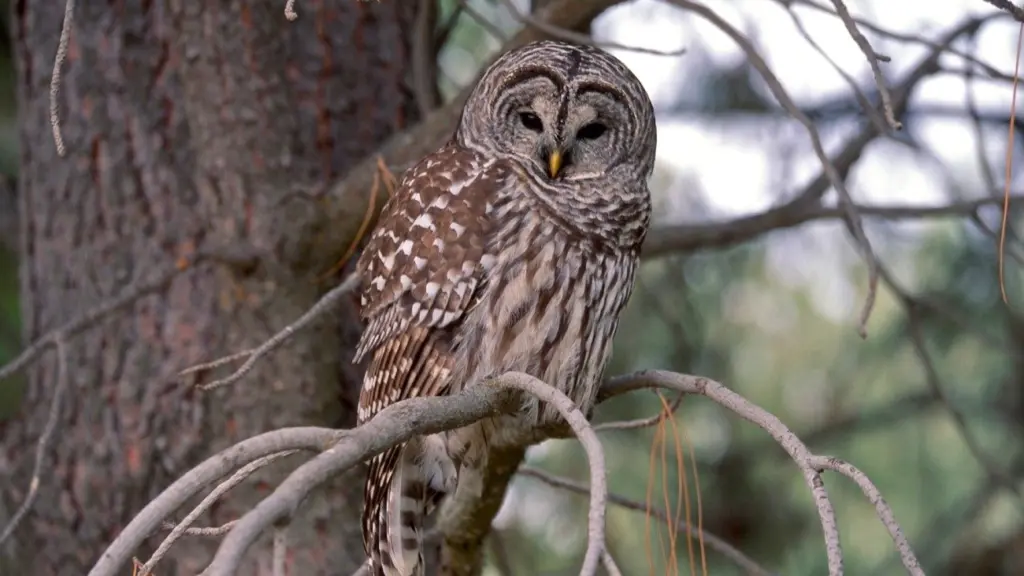OREGON – A controversial plan to kill up to half a million invasive barred owls to protect endangered spotted owls is in jeopardy after the Trump administration terminated three critical grants funding the program.
The U.S. Fish and Wildlife Service’s barred owl management strategy was approved last September.
The plan, set to start this year and continue for three decades, called for lethal removal of barred owls in Washington, Oregon and California by shooting them with shotguns or, less frequently, capturing and euthanizing them.
Barred owls and spotted owls prefer the same habitat and compete for the same food. But the barred owl is larger and more aggressive, and typically prevails in conflicts with the spotted owl.
Julia Smith, endangered species recovery section manager for the Washington Department of Fish and Wildlife, told the state Fish and Wildlife Commission last week that the northern spotted owl will be functionally extinct in Washington within the next decade if no new action is taken.
“There’s no easy button to recover this bird, and we’re left with only the most difficult options,” Smith said.
The U.S. Fish and Wildlife Service has said its plan to shoot barred owls would result in the annual removal of less than one-half of 1% of the species’ North American population.
Animal rights activists and lawmakers on both sides of the aisle have publicly opposed the plan, calling it costly, unsustainable and inhumane.
Now, the Trump administration has canceled $1.1 million in grants to the California Department of Fish and Wildlife to enact the program, the Los Angeles Times reported Saturday.
The grant cancellation is the first public indication of the administration’s stance on the plan.
Animal Wellness Action and the Center for a Humane Economy, two animal rights activist groups that have led a national fight against the plan, said Monday the grant cancellation marks a turning point in the debate over whether to kill the invasive owls.
“Americans don’t want to finance shooting North American owls in national parks from Olympic to Crater Lake to Yosemite,” said Wayne Pacelle, president of Animal Wellness Action and the Center for a Humane Economy.
Animal Wellness Action and the Center for a Humane Economy estimate the 30-year plan could cost up to $1.35 billion.
An official cost estimate has not been released.
The activist groups cited a $4.5 million grant awarded last year to the Hoopa Valley Tribe in California to kill 1,500 owls over four years — a cost of roughly $3,000 per bird.
While the barred owl management strategy is controversial, the U.S. Fish and Wildlife Service says it’s necessary to stabilize the spotted owl population.
Washington is home to the endangered northern spotted owl, and the Washington Department of Fish and Wildlife is included on the U.S. Fish and Wildlife’s list of agencies cooperating with the barred owl removal plan.
The northern spotted owl was designated as “threatened” under the federal Endangered Species Act nearly 25 years ago.
In the Pacific Northwest, spotted owls are known for their central role in the “timber wars” of the 1980s and 1990s, which pitted environmentalists concerned about saving old-growth trees against loggers.
This conflict eventually led to the 1994 Northwest Forest Plan, which put new protections in place for forests where the spotted owl lives.
The U.S. Fish and Wildlife Service says that the rate of spotted owl population declines showed signs of improvement until about 2008, but accelerated soon after, and that the downturn coincided with the expansion of barred owls into spotted owls’ territory.
Smith, with the state Department of Fish and Wildlife, said modeling of what would happen if barred owls were no longer present in Washington showed the spotted owl population growing steadily for the next 15 years and stabilizing in 30 to 40 years.
The simulation also showed that, if not completely eliminated from the state, barred owl populations would recover and stabilize as soon as management efforts stopped.
“Control across a large region would be incredibly expensive, and you’d have to keep doing it forever,” former U.S. Forest Service wildlife biologist Dr. Eric Forsman, who helped pioneer protections for spotted owls, said in a statement published by Animal Wellness Action and the Center for a Humane Economy. “In the long run, we’re just going to have to let the two species work it out.”
Barred owl population control is one part of Washington’s three-pronged plan to save the spotted owl from extinction.
Breeding programs to grow the spotted owl population and maintenance of old-growth forest habitat are the other two strategies Washington relies on.
Smith noted that none of these methods alone would be enough to save the spotted owl. “We’ll need to do all three of these things together,” she said.
This story first appeared on Washington State Standard.
